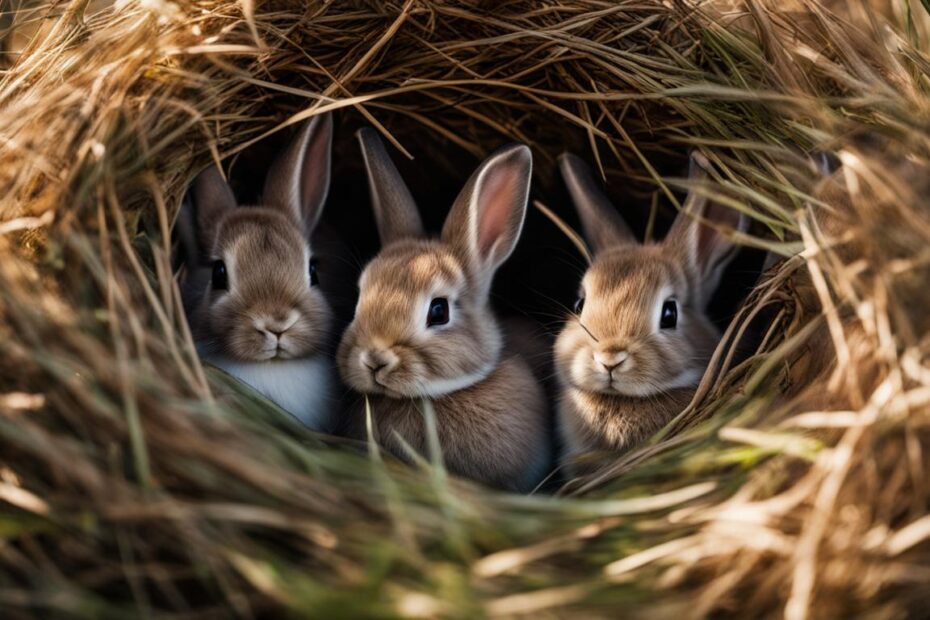When it comes to the fascinating world of rabbits, there are many mysteries and questions that pique our curiosity. One common question that often arises is whether rabbits are born blind. Today, we will delve into this topic and uncover the truth behind their vision development.
Key Takeaways:
- Newborn rabbits are indeed born blind, with their eyes remaining closed for about 7 days after birth.
- Baby rabbits gradually develop their vision, with their eyes opening around the 7-day mark.
- Vision plays a crucial role in the survival and behavior of rabbits, as they rely on it to navigate their surroundings, find food, and avoid predators.
- Despite being born blind, baby rabbits have other adaptations such as a strong sense of smell and touch to aid in their survival.
- Mother rabbits provide essential care and protection to their blind newborns until their eyes open and they can see their surroundings.
The Development of Rabbit’s Vision
Baby rabbits, also known as kits or bunnies, are born with their eyes closed and are initially blind. However, their vision gradually develops after birth. Around 7 days old, their eyes begin to open, allowing them to see their surroundings for the first time. This milestone marks the beginning of their visual development journey. It is fascinating to observe how their vision progresses in the following weeks.
The opening of baby rabbits’ eyes at around 7 days is an important step in their visual ability. As their eyes become fully open, they start to explore their environment, using their newfound sense of sight to navigate and interact with their surroundings. This visual exploration is crucial for their cognitive and physical development.
During the first weeks after their eyes open, baby rabbits continue to refine their visual acuity and depth perception. They gradually gain a better understanding of distance and movement, which helps them become more skilled at finding food, avoiding obstacles, and recognizing potential threats. Their vision plays a vital role in their survival and overall well-being.
| Developmental Milestones in Rabbit’s Vision | Age |
|---|---|
| Opening of eyes | Around 7 days |
| Better visual acuity and depth perception | Following weeks after eye opening |
| Full visual development | Continues as rabbits grow |
Vision Development Milestones
- Opening of eyes around 7 days old
- Gradual improvement in visual acuity and depth perception in the following weeks
- Continued visual development as rabbits grow
Seeing the world for the first time, baby rabbits embark on a transformative journey of visual development. From the moment their eyes open, they eagerly explore their environment, relying on their emerging vision to navigate the world around them. It is awe-inspiring to witness how their visual abilities evolve, enabling them to thrive in their habitats.
Factors Affecting Rabbit’s Vision at Birth
When it comes to the vision of newborn rabbits, they are born blind. This is a natural part of their development, and their eyes remain closed for approximately seven days after birth. During this time, their vision is limited, and they rely on other senses, such as touch and smell, to navigate their surroundings. It is only after this initial period that their eyes start to open, allowing them to gradually gain the ability to see and explore.
Why are rabbits born blind? This blindness at birth is a result of the incomplete development of their eyes. Just like many other mammals, their eyes need time to fully develop before they can function properly. While they may not have sight right from the start, this temporary blindness does not hinder their survival. In fact, it is believed to be an evolutionary adaptation that helps protect them while they are most vulnerable.
“The closed eyes of newborn rabbits serve as a protective mechanism, shielding their underdeveloped eyes from potential harm and allowing them to focus on growth and development,” explains Dr. Jane Wilson, a wildlife biologist. “This period of temporary blindness is crucial for their overall well-being and ensures that their eyes mature before they are exposed to the outside environment.”
As the days go by and their eyes gradually open, rabbit babies begin to experience the world around them. Their vision improves over time, allowing them to see their surroundings, find food, and recognize potential threats. It is fascinating to witness the development of their vision and how it enhances their ability to thrive in their environment.
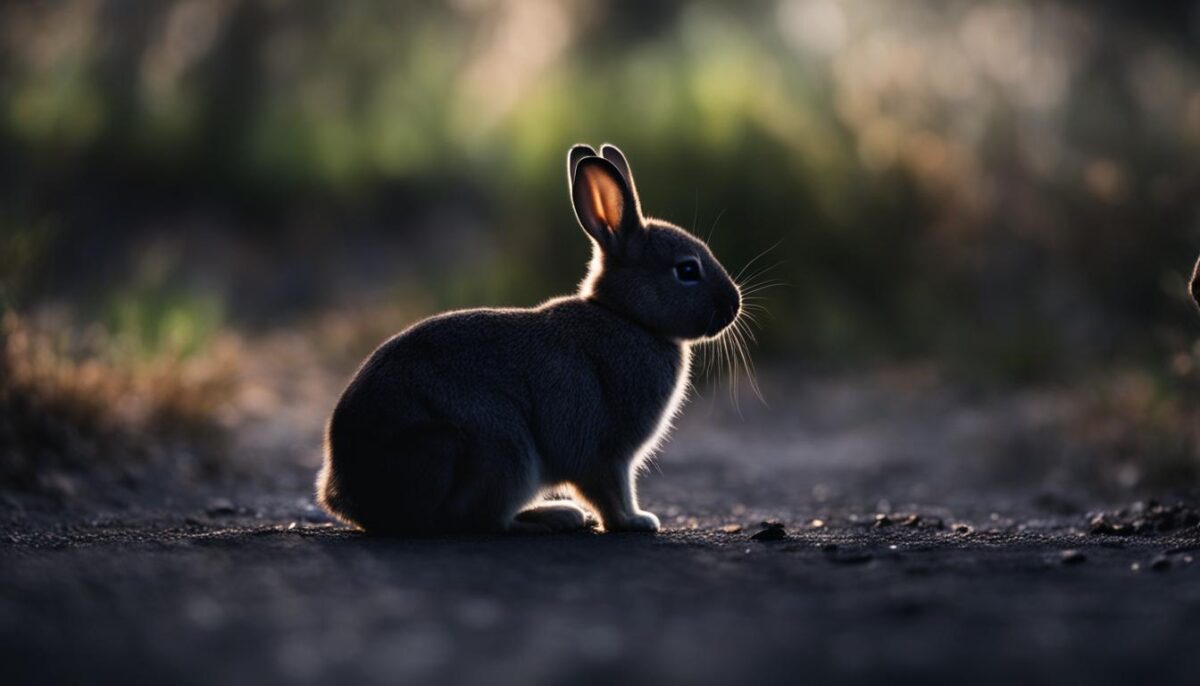
Table: Development of Rabbit’s Vision
| Stage | Description |
|---|---|
| Birth | Rabbit babies are born blind with closed eyes |
| First week | Eyes start to open gradually |
| Following weeks | Vision improves, allowing them to see and explore their environment |
| Full development | Rabbit’s vision reaches maturity |
The Importance of Vision for Rabbits
Vision plays a crucial role in the survival and behavior of rabbits. Once their eyes open around 7 days after birth, they rely on their vision to navigate their surroundings, find food, and avoid predators.
Rabbits have a wide field of vision, with their eyes positioned on the sides of their head, allowing them to see nearly 360 degrees. This unique visual perspective helps them detect potential threats from all directions. Their eyesight also helps them in foraging for food. They are able to spot tender vegetation from a distance and accurately judge their proximity to obstacles.
“Rabbits are born with their eyes closed, but once they open, their vision becomes an essential sense for their survival,” says Dr. Emily Johnson, a veterinarian specializing in small mammals. “Their keen eyesight helps them explore their environment and detect any signs of danger.”
Rabbits have a natural instinct to freeze when they sense danger, relying on their visual acuity to assess their surroundings and decide on the best course of action. Their ability to see in low light conditions also gives them an advantage in staying alert during dawn and dusk, when many predators are most active.
In conclusion, the development of vision in rabbits is a significant milestone in their early growth. As their eyes open and their vision improves, they become more independent and capable of navigating their world with confidence.
Rabbit’s Vision Development in the First Weeks
After being born blind, a newborn rabbit’s vision gradually develops within the first few weeks of life. It takes approximately 7 days for their eyes to open, revealing their surroundings for the first time. During this period, their visual acuity and depth perception continue to improve, allowing them to navigate their environment with increasing precision.
As their vision develops, baby rabbits become more aware of their surroundings and start exploring their surroundings. They begin to recognize their mother’s scent and movements, which helps them identify a source of food and learn vital survival skills.
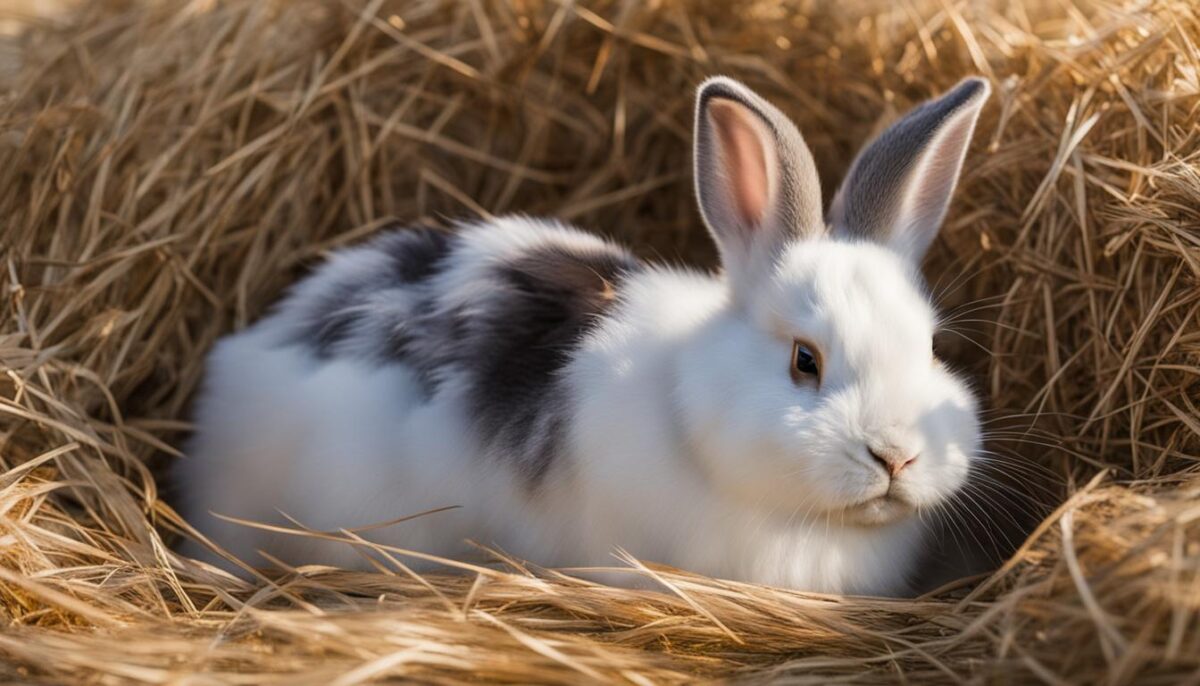
The progression of their vision is a crucial milestone in their growth. It enables them to effectively find food, avoid predators, and interact with their siblings and environment. Although newborn rabbits are initially blind, their developing visual abilities play a significant role in ensuring their survival and successful transition into independent individuals.
Table: Rabbit’s Vision Development Milestones
| Age | Vision Development Milestones |
|---|---|
| 0-7 days | Eyes closed, born blind |
| Around 7 days | Eyes open, limited vision |
| 2-3 weeks | Better visual acuity and depth perception |
| 4-6 weeks | Fully developed vision |
It’s important to note that individual rabbits may have slight variations in their vision development timeline, but the general sequence remains consistent across the species.
Adaptations for Survival as Blind Babies
Although newborn rabbits are born blind, they possess remarkable adaptations that help them navigate their surroundings and ensure their survival. While their vision is still developing, they rely on their other senses, such as their strong sense of smell and touch, to explore and interact with their environment.
These adaptations allow blind baby rabbits to locate their mother and siblings, find their nest, and access their mother’s milk for nourishment. Their sense of smell is particularly crucial during this time, as it helps them identify their mother’s scent and distinguish her from other rabbits or predators.
Rabbits also have a highly developed sense of touch, which they use to navigate their nest and interact with their siblings. Through gentle nudges and physical contact, they communicate with each other and establish social bonds within their family unit.
This period of dependency on their other senses is temporary, as their eyes begin to open around 7 days after birth. Once their vision develops, baby rabbits will gradually rely more on their sight to explore and interact with the world around them.
“Nature equips blind baby rabbits with extraordinary adaptations that compensate for their lack of vision, ensuring their survival and growth until their eyes open and their vision develops.”
While blindness at birth might seem like a disadvantage, it’s a natural part of a rabbit’s life cycle. These adaptations highlight the resilience and resourcefulness of these adorable creatures and serve as a reminder of the wonders of nature’s design.
| Adaptations for Survival as Blind Babies | Description |
|---|---|
| Sharp Sense of Smell | Rabbits rely on their sense of smell to identify their mother, siblings, and food sources. |
| Heightened Sense of Touch | Rabbits use their sense of touch to navigate their nest and interact with their siblings. |
| Dependency on Maternal Care | Blind baby rabbits rely on their mother for warmth, protection, and nourishment until their eyes open and their vision develops. |
References:
- Source 1
- Source 2
- Source 3
The Role of Maternal Care in Rabbit’s Vision Development
When it comes to the development of a newborn rabbit’s vision, maternal care plays a crucial role. Baby rabbits are born with their eyes closed, rendering them blind at birth. It is through the attentive care and protection of their mother that they are able to navigate those initial days of darkness.
With their eyes closed, blind baby bunnies rely on their mother to keep them safe in the nest. The mother rabbit ensures that the nest provides a warm and secure environment, shielding her blind offspring from potential dangers. She also provides nourishment through nursing, which is essential for their overall growth and development.
As the days pass, the mother rabbit patiently waits for her babies’ eyes to open. This usually occurs around the 7-day mark, at which point the newborn rabbits can finally see the world around them. Their vision begins to develop, allowing them to explore their surroundings and start the process of gaining independence.
| Maternal Care and Rabbit Vision Development | |
|---|---|
| Stage | Description |
| Birth | Blind with closed eyes |
| Days 1-7 | Mother provides care and protection |
| Around day 7 | Eyes open, vision development begins |
| Weeks following eye opening | Continued visual development and exploration |
| 4-6 weeks old | Independence from mother |
The role of maternal care can be observed as a key factor in the vision development of baby rabbits. Without the watchful eyes and nurturing presence of their mother, these blind newborns would face significant challenges. Yet, with maternal guidance and protection, they are able to journey from darkness to sight, setting the stage for a future of exploration and survival.
Growth Milestones in Rabbit’s Vision Development
When it comes to the development of a rabbit’s vision, there are several important milestones to note. The opening of their eyes at around 7 days old is a significant event. At this stage, their visual journey begins, and they start to perceive the world around them. It marks the point when they can start exploring and interacting with their environment.
As their vision continues to develop, rabbits gain better visual acuity and depth perception in the following weeks. They become more adept at identifying objects and distinguishing colors. This development is crucial for their survival, as they rely on their vision to find food, avoid predators, and navigate their surroundings.
While their eyes open at 7 days, rabbit babies are still dependent on their mother for nourishment at this stage. The weaning process typically occurs at around 4 to 6 weeks old. During this time, they transition from solely relying on their mother’s milk to starting to eat solid foods. Weaning is a crucial milestone in a rabbit’s life, as it signifies their increasing independence and ability to survive on their own.
| Growth Milestones | Timing |
|---|---|
| Eyes open | Around 7 days old |
| Weaning | 4 to 6 weeks old |
Through these growth milestones in their vision development, rabbits progress from being blind and dependent to having fully functional eyesight and the ability to thrive in their environment. It is fascinating to witness their transformation as they become more aware of their surroundings and acquire the visual skills necessary for their survival.
Common Vision Problems in Rabbits
Rabbits, like any other living creatures, can experience various eye problems throughout their lives. These issues can range from minor irritations to more serious conditions that require veterinary intervention. Being aware of these common vision problems can help rabbit owners identify and address them promptly, ensuring the well-being of their furry companions.
Types of Eye Problems
There are several eye problems that rabbits may encounter:
- Conjunctivitis: Also known as “pink eye,” this condition involves inflammation of the conjunctiva, the thin membrane that covers the inner eyelids and the white part of the eye. It can cause redness, discharge, and discomfort.
- Cataracts: Cataracts can develop in rabbits, leading to a cloudy or opaque appearance in the eye. They can interfere with a rabbit’s vision if left untreated.
- Corneal ulcers: These are open sores on the cornea, the clear outer layer of the eye. Corneal ulcers can be caused by injuries, infections, or irritants and may result in pain, discharge, and squinting.
- Dental problems: Dental issues, such as overgrown teeth, can cause eye problems in rabbits. Misaligned or overgrown teeth can put pressure on the eye, leading to issues like corneal ulcers or abscesses.
Prevention and Treatment
Preventing eye problems in rabbits involves maintaining good hygiene and providing a healthy environment. Regular cleaning of the rabbit’s living area, ensuring proper ventilation, and regular veterinary check-ups can help identify any potential eye problems early on.
“Early detection and treatment of eye problems in rabbits is crucial for successful outcomes. If you notice any changes in your rabbit’s eye appearance or behavior, it’s important to consult a veterinarian as soon as possible.”
Treatment for eye problems will depend on the specific condition and its severity. It may include medication, eye drops, or ointments prescribed by a veterinarian. In some cases, surgery may be required to address underlying issues like cataracts or corneal ulcers.
In conclusion, while rabbits generally have good vision, they can be prone to various eye problems. Being proactive in monitoring their eye health and seeking professional care when needed can help ensure their eyesight is protected and maintained throughout their lives.
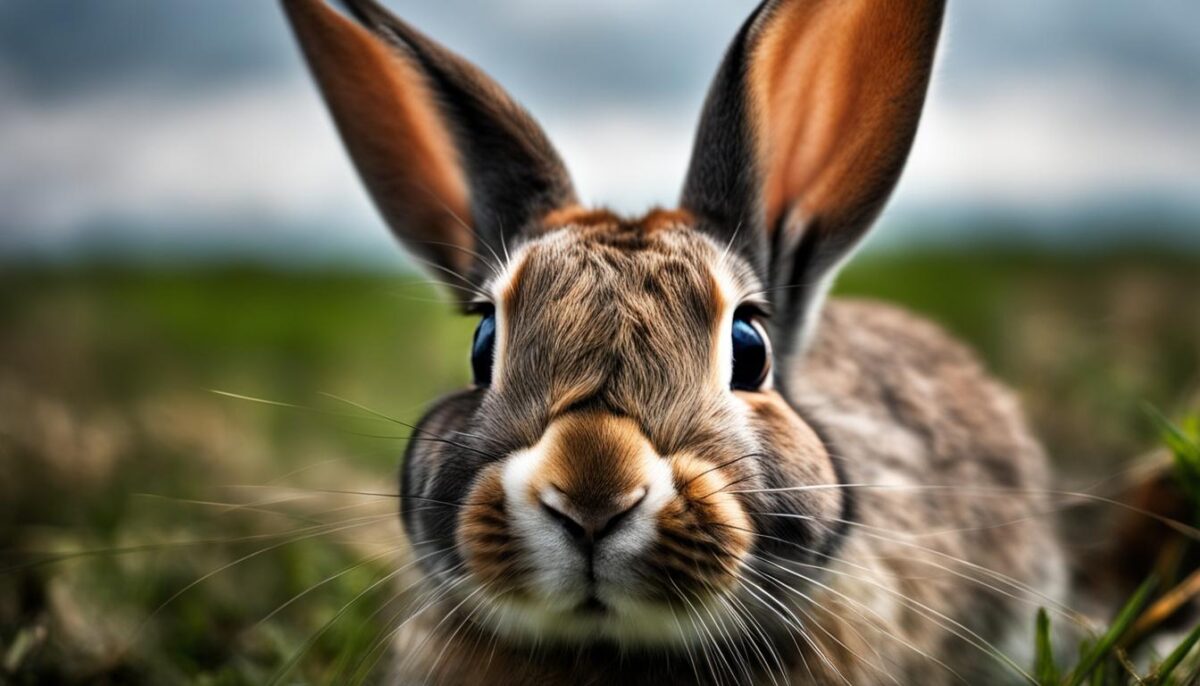
Rabbit’s Vision in the Wild: Environmental Factors at Play
Rabbits, both domestic and wild, rely heavily on their vision to navigate their environment, locate food sources, and detect potential predators. In the wild, several environmental factors can impact a rabbit’s vision and ultimately influence its survival.
Lighting Conditions
In their natural habitat, rabbits encounter varying lighting conditions, from bright sunlight to dimly lit areas. These changing light levels can affect their ability to see clearly and may require them to quickly adapt their vision to different environments. For example, in bright sunlight, rabbits may squint or adjust their pupils to reduce glare and enhance their vision. Conversely, in low-light conditions, rabbits may rely on their other senses, such as their acute hearing and sense of smell, to compensate for limited visibility.
Predators
The presence of predators is a significant factor influencing a rabbit’s visual behavior. Rabbits have evolved to have a wide field of vision, with eyes positioned on the sides of their heads, allowing them to detect potential threats from all directions. The ability to see predators approaching from the sides or behind is critical for their survival. Additionally, rabbits have excellent peripheral vision, which helps them detect sudden movements and distinguish between potential threats and harmless stimuli in their surroundings.
Habitat Obstacles
Rabbits inhabit diverse environments, including grasslands, forests, and deserts, which may present various obstacles that can hinder their vision. Dense vegetation, tall grass, or rocky terrain can limit their line of sight and make it challenging to see potential predators or obstacles in their path. To overcome these challenges, rabbits rely on their ability to quickly assess their surroundings and use their other senses, such as hearing and touch, to navigate safely.
| Environmental Factors | Impact on Rabbit’s Vision |
|---|---|
| Lighting Conditions | Affects visibility and may require visual adaptation |
| Predators | Influences visual behavior, wide field of vision, peripheral vision |
| Habitat Obstacles | Limits line of sight, reliance on other senses for navigation |
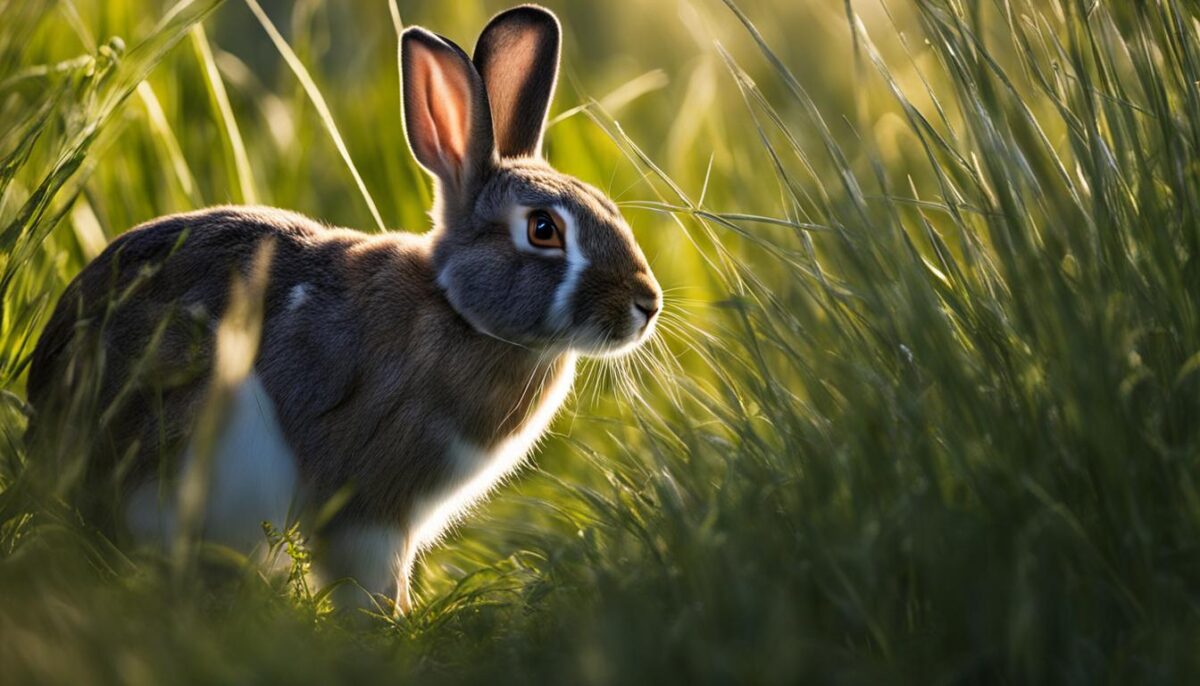
In summary, environmental factors play a crucial role in a rabbit’s vision in the wild. Lighting conditions, the presence of predators, and habitat obstacles can significantly impact their visual abilities and influence their survival strategies. Rabbits have evolved to adapt to these varying conditions, utilizing their wide field of vision, peripheral vision, and other senses to overcome challenges and thrive in their natural habitat.
Conservation Efforts for Rabbit’s Vision
Rabbits play an essential role in ecosystems and wildlife communities. As such, conservation efforts are crucial to maintaining their populations and preserving their vision and overall health. These efforts focus on various strategies aimed at protecting rabbit’s eyesight and ensuring their long-term viability.
Habitat Preservation
One of the primary objectives of rabbit vision conservation is the preservation of suitable habitats. By protecting and restoring their natural habitats, conservationists provide rabbits with the necessary environments to thrive. This includes ensuring ample vegetation cover, diverse foraging opportunities, and suitable shelter to support their vision development and daily activities.
Predator Management
Rabbits are often at risk from predators, which can pose a threat to their vision and overall well-being. Conservation efforts employ predator management techniques, such as habitat manipulation, predator deterrence, and targeted control measures. These strategies help minimize predation pressure on rabbit populations, reducing the risk of vision-related injuries and ensuring their long-term survival.
Disease Prevention and Monitoring
Regular veterinary check-ups and disease monitoring programs are essential components of rabbit vision conservation. By implementing preventive measures and early detection protocols, conservationists can identify and address eye-related diseases promptly. This approach helps minimize the impact of diseases on rabbit populations and ensures that any vision impairments are appropriately managed and treated.
| Conservation Strategies | Description |
|---|---|
| Habitat Preservation | Protecting and restoring suitable habitats to support rabbit populations and vision development. |
| Predator Management | Implementing techniques to reduce predation pressure on rabbits, minimizing vision-related injuries. |
| Disease Prevention and Monitoring | Regular check-ups and monitoring programs to detect and manage eye-related diseases. |
Through these conservation efforts, researchers and conservationists strive to safeguard rabbit populations and their vision for future generations. By understanding the challenges they face and implementing targeted measures, we can contribute to the preservation of these remarkable creatures and ensure their continued existence in the wild.
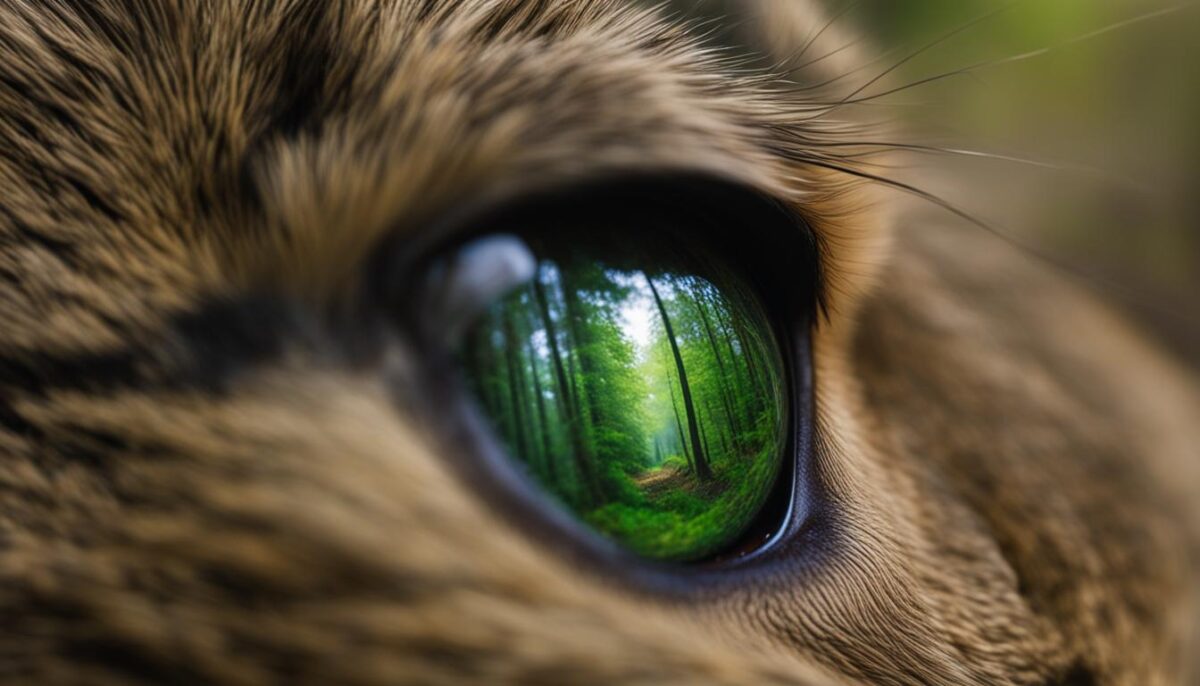
Conclusion
While rabbits are born blind, their vision undergoes significant development after birth. Newborn rabbits have closed eyes and rely on other senses like smell and touch to navigate their environment. However, around 7 days old, their eyes open, marking a crucial milestone in their visual development.
As their vision continues to improve, rabbits become more proficient in perceiving their surroundings, gaining visual acuity and depth perception. This visual development is essential for their survival, as it enables them to find food, avoid predators, and explore their habitat.
Conservation efforts play a vital role in protecting the vision and overall well-being of wild rabbit populations. By preserving suitable habitats, reducing threats from predators and diseases, and promoting sustainable measures, conservationists aim to ensure the long-term viability of rabbits and their continued visual development.
FAQ
Are rabbits born blind?
Yes, newborn rabbits are born blind.
How long do rabbit babies stay blind?
Their eyes remain closed for about 7 days after birth.
When do baby rabbits start to see?
Baby rabbits’ eyes open around 7 days old.
Why are baby rabbits born blind?
It is a natural part of their development, and their vision improves as they grow.
How important is vision for rabbits?
Vision plays a crucial role in their survival and behavior.
Do baby rabbits have other senses to rely on when they are blind?
Yes, they have a strong sense of smell and touch.
How long does it take for a newborn rabbit’s vision to fully develop?
Their eyes open around 7 days, and their vision gradually improves in the following weeks.
How do mother rabbits take care of their blind newborns?
Mother rabbits keep them in the nest, ensuring their safety until their eyes open.
At what age do rabbit babies become independent from their mother?
They become fully independent at around 4-6 weeks old.
Can rabbits have eye problems?
Yes, they can experience infections, injuries, or cataracts.
What factors can affect the vision of wild rabbits?
Lighting conditions, predators, and obstacles in their habitat can affect their vision.
What are conservation efforts doing to protect rabbit’s vision?
Conservation efforts focus on preserving suitable habitats, reducing threats, and promoting measures for their long-term viability.
Are newborn rabbits blind forever?
No, their vision gradually develops after birth.


